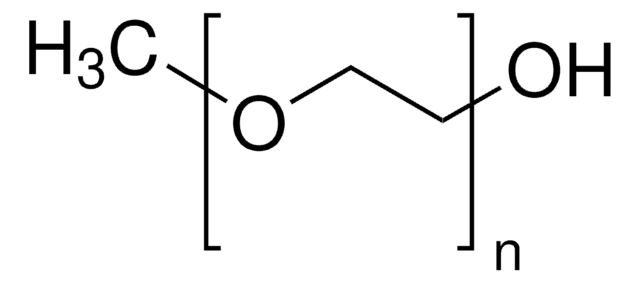81323
Poly(ethylene glycol) methyl ether
average MN 5,000, methoxy, hydroxyl
Sinonimo/i:
Polyethylene glycol monomethyl ether
About This Item
Prodotti consigliati
Nome del prodotto
Poly(ethylene glycol) methyl ether, average Mn 5,000
Densità del vapore
>1 (vs air)
Livello qualitativo
Tensione di vapore
0.05 mmHg ( 20 °C)
Stato
flakes
powder or crystals
PM
average Mn 5,000
Punto di fusione
60-64 °C
Estremità Ω
hydroxyl
Estremità α
methoxy
Stringa SMILE
O(CCO)C
InChI
1S/C3H8O2/c1-5-3-2-4/h4H,2-3H2,1H3
XNWFRZJHXBZDAG-UHFFFAOYSA-N
Cerchi prodotti simili? Visita Guida al confronto tra prodotti
Categorie correlate
Applicazioni
Altre note
Prodotti correlati
Codice della classe di stoccaggio
10 - Combustible liquids
Classe di pericolosità dell'acqua (WGK)
WGK 1
Punto d’infiammabilità (°F)
359.6 °F - closed cup
Punto d’infiammabilità (°C)
182 °C - closed cup
Dispositivi di protezione individuale
Eyeshields, Gloves
Scegli una delle versioni più recenti:
Certificati d'analisi (COA)
Non trovi la versione di tuo interesse?
Se hai bisogno di una versione specifica, puoi cercare il certificato tramite il numero di lotto.
Possiedi già questo prodotto?
I documenti relativi ai prodotti acquistati recentemente sono disponibili nell’Archivio dei documenti.
Articoli
Fouling Resistant Biomimetic Poly(Ethylene Glycol) Based Grafted Polymer Coatings
Progress in biotechnology fields such as tissue engineering and drug delivery is accompanied by an increasing demand for diverse functional biomaterials. One class of biomaterials that has been the subject of intense research interest is hydrogels, because they closely mimic the natural environment of cells, both chemically and physically and therefore can be used as support to grow cells. This article specifically discusses poly(ethylene glycol) (PEG) hydrogels, which are good for biological applications because they do not generally elicit an immune response. PEGs offer a readily available, easy to modify polymer for widespread use in hydrogel fabrication, including 2D and 3D scaffold for tissue culture. The degradable linkages also enable a variety of applications for release of therapeutic agents.
Devising biomaterial scaffolds that are capable of recapitulating critical aspects of the complex extracellular nature of living tissues in a threedimensional (3D) fashion is a challenging requirement in the field of tissue engineering and regenerative medicine.
Il team dei nostri ricercatori vanta grande esperienza in tutte le aree della ricerca quali Life Science, scienza dei materiali, sintesi chimica, cromatografia, discipline analitiche, ecc..
Contatta l'Assistenza Tecnica.


